Shujuan Yin
A Simple but Effective Bidirectional Framework for Relational Triple Extraction
Jan 05, 2022
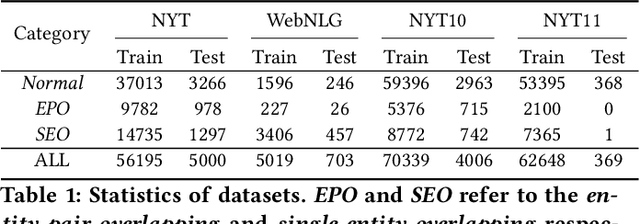
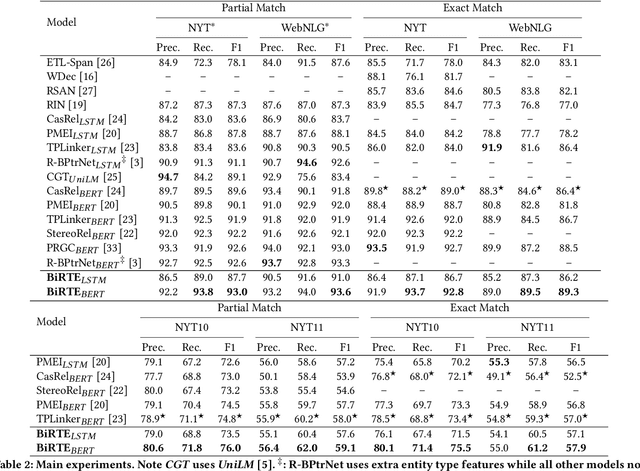

Abstract:Tagging based relational triple extraction methods are attracting growing research attention recently. However, most of these methods take a unidirectional extraction framework that first extracts all subjects and then extracts objects and relations simultaneously based on the subjects extracted. This framework has an obvious deficiency that it is too sensitive to the extraction results of subjects. To overcome this deficiency, we propose a bidirectional extraction framework based method that extracts triples based on the entity pairs extracted from two complementary directions. Concretely, we first extract all possible subject-object pairs from two paralleled directions. These two extraction directions are connected by a shared encoder component, thus the extraction features from one direction can flow to another direction and vice versa. By this way, the extractions of two directions can boost and complement each other. Next, we assign all possible relations for each entity pair by a biaffine model. During training, we observe that the share structure will lead to a convergence rate inconsistency issue which is harmful to performance. So we propose a share-aware learning mechanism to address it. We evaluate the proposed model on multiple benchmark datasets. Extensive experimental results show that the proposed model is very effective and it achieves state-of-the-art results on all of these datasets. Moreover, experiments show that both the proposed bidirectional extraction framework and the share-aware learning mechanism have good adaptability and can be used to improve the performance of other tagging based methods. The source code of our work is available at: https://github.com/neukg/BiRTE.
A Novel Global Feature-Oriented Relational Triple Extraction Model based on Table Filling
Sep 14, 2021Abstract:Table filling based relational triple extraction methods are attracting growing research interests due to their promising performance and their abilities on extracting triples from complex sentences. However, this kind of methods are far from their full potential because most of them only focus on using local features but ignore the global associations of relations and of token pairs, which increases the possibility of overlooking some important information during triple extraction. To overcome this deficiency, we propose a global feature-oriented triple extraction model that makes full use of the mentioned two kinds of global associations. Specifically, we first generate a table feature for each relation. Then two kinds of global associations are mined from the generated table features. Next, the mined global associations are integrated into the table feature of each relation. This "generate-mine-integrate" process is performed multiple times so that the table feature of each relation is refined step by step. Finally, each relation's table is filled based on its refined table feature, and all triples linked to this relation are extracted based on its filled table. We evaluate the proposed model on three benchmark datasets. Experimental results show our model is effective and it achieves state-of-the-art results on all of these datasets. The source code of our work is available at: https://github.com/neukg/GRTE.
A Three-Stage Learning Framework for Low-Resource Knowledge-Grounded Dialogue Generation
Sep 09, 2021

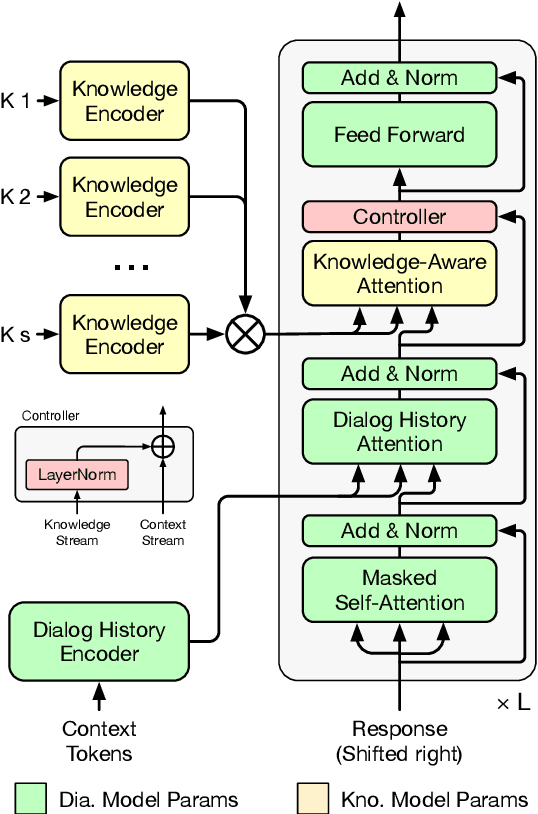

Abstract:Neural conversation models have shown great potentials towards generating fluent and informative responses by introducing external background knowledge. Nevertheless, it is laborious to construct such knowledge-grounded dialogues, and existing models usually perform poorly when transfer to new domains with limited training samples. Therefore, building a knowledge-grounded dialogue system under the low-resource setting is a still crucial issue. In this paper, we propose a novel three-stage learning framework based on weakly supervised learning which benefits from large scale ungrounded dialogues and unstructured knowledge base. To better cooperate with this framework, we devise a variant of Transformer with decoupled decoder which facilitates the disentangled learning of response generation and knowledge incorporation. Evaluation results on two benchmarks indicate that our approach can outperform other state-of-the-art methods with less training data, and even in zero-resource scenario, our approach still performs well.
A Conditional Cascade Model for Relational Triple Extraction
Aug 20, 2021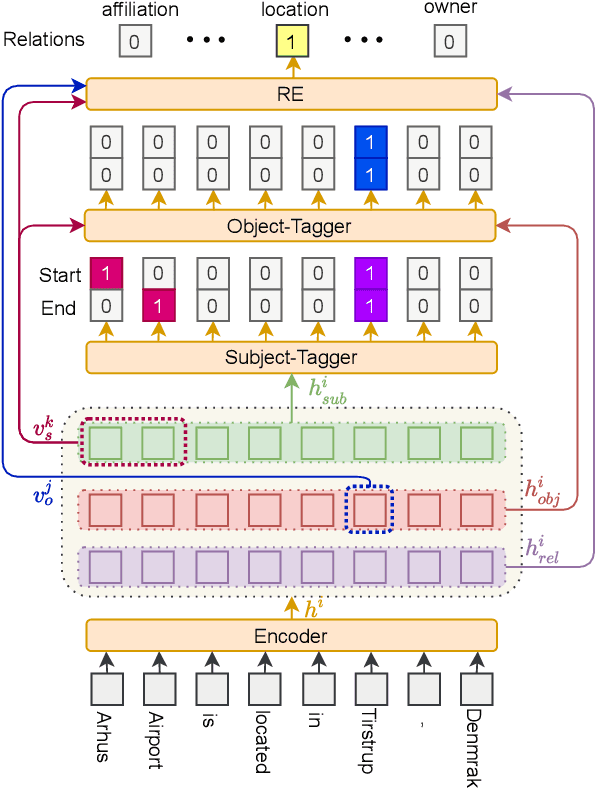
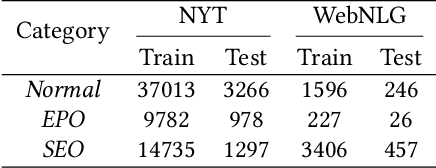
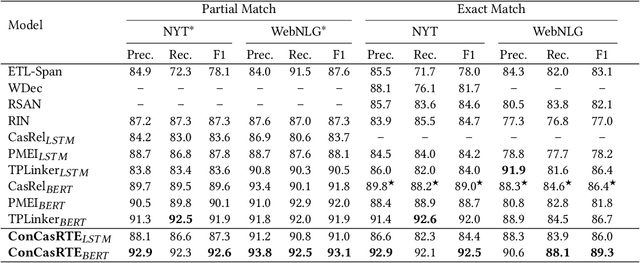

Abstract:Tagging based methods are one of the mainstream methods in relational triple extraction. However, most of them suffer from the class imbalance issue greatly. Here we propose a novel tagging based model that addresses this issue from following two aspects. First, at the model level, we propose a three-step extraction framework that can reduce the total number of samples greatly, which implicitly decreases the severity of the mentioned issue. Second, at the intra-model level, we propose a confidence threshold based cross entropy loss that can directly neglect some samples in the major classes. We evaluate the proposed model on NYT and WebNLG. Extensive experiments show that it can address the mentioned issue effectively and achieves state-of-the-art results on both datasets. The source code of our model is available at: https://github.com/neukg/ConCasRTE.
An Effective System for Multi-format Information Extraction
Aug 16, 2021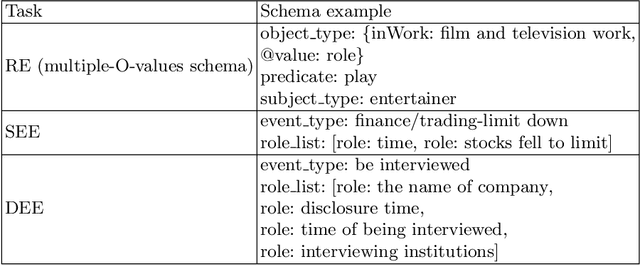

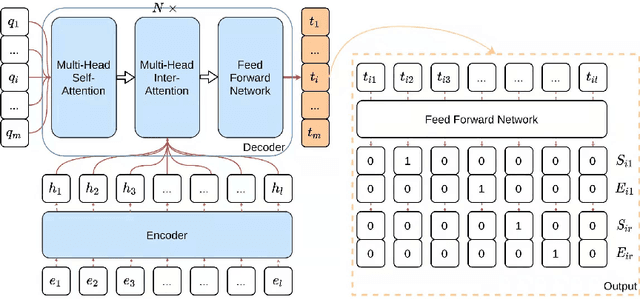

Abstract:The multi-format information extraction task in the 2021 Language and Intelligence Challenge is designed to comprehensively evaluate information extraction from different dimensions. It consists of an multiple slots relation extraction subtask and two event extraction subtasks that extract events from both sentence-level and document-level. Here we describe our system for this multi-format information extraction competition task. Specifically, for the relation extraction subtask, we convert it to a traditional triple extraction task and design a voting based method that makes full use of existing models. For the sentence-level event extraction subtask, we convert it to a NER task and use a pointer labeling based method for extraction. Furthermore, considering the annotated trigger information may be helpful for event extraction, we design an auxiliary trigger recognition model and use the multi-task learning mechanism to integrate the trigger features into the event extraction model. For the document-level event extraction subtask, we design an Encoder-Decoder based method and propose a Transformer-alike decoder. Finally,our system ranks No.4 on the test set leader-board of this multi-format information extraction task, and its F1 scores for the subtasks of relation extraction, event extractions of sentence-level and document-level are 79.887%, 85.179%, and 70.828% respectively. The codes of our model are available at {https://github.com/neukg/MultiIE}.
 Add to Chrome
Add to Chrome Add to Firefox
Add to Firefox Add to Edge
Add to Edge